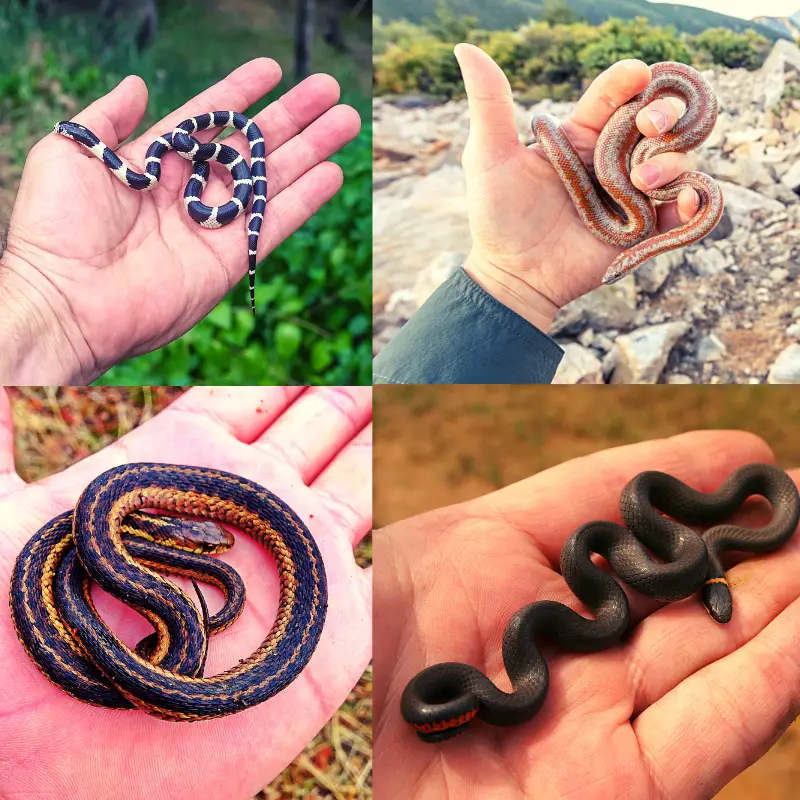Snakes are fantastic pets, and being a snake owner is an extraordinary task. A pet snake can be a great responsibility for any family because they’re so unique. Check out these smaller snakes, which will be perfect for beginners. They are easy to handle, and since they are so small, care is at its minimin.
Why Smaller Snakes Are Better For Beginners
It is way easier to handle a smaller snake in various ways than the bigger ones if you are a beginner.
The small snakes require less living space and less maintenance.
You only need a small amount of know-how and Research to keep these snakes healthy.
Some small snake species, like Western hognose snakes, ringneck snakes, ball pythons, garter snakes, California Kingsnakes, milk snakes, all make exceptional pets for beginners.
Below I have listed the names of the small snake species that are most suitable for beginners and easy to care for.
1. Rosy Boa
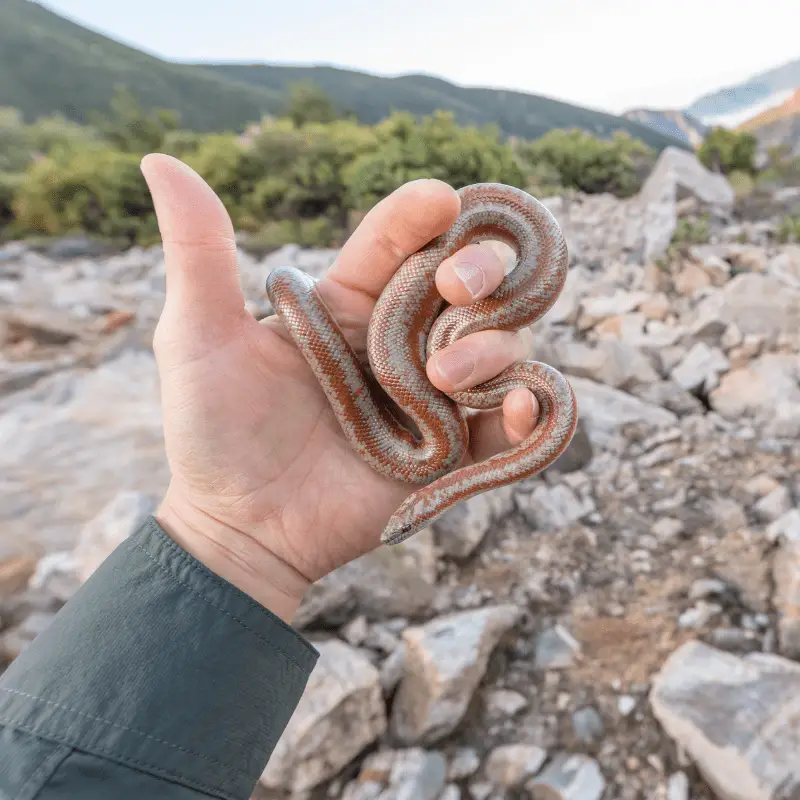
These are beautiful little snakes that are pretty common, affordable, non-venomous and have a docile personality. They come in beautiful patterns and colours.
Size
A small snake, the Rosy Boa, attains a total length (including tail) of 17-34 inches (43-86 cm), although some coastal specimens from California reach 36-44 inches (91-112 cm).
How long do Rosy Boa snakes live in captivity?
The rosy boa snakes can live up to 25 years in captivity.
The beginners should start their journey with a 20-gallon enclosure for the Rosy Boas. Make sure to keep only one snake per tank. Use paper towels, newspaper, or aspen bedding for creating substrate. Escape proofing the enclosure is yet another vital step that you should not overlook. The Rosy Boas are well known for their escaping tendencies.
These snakes often come in several different morphs. While some of the complex morphs of the Rosy Boa can be expensive, most of them are pretty pocket-friendly for first-time buyers.
2. Ball Python
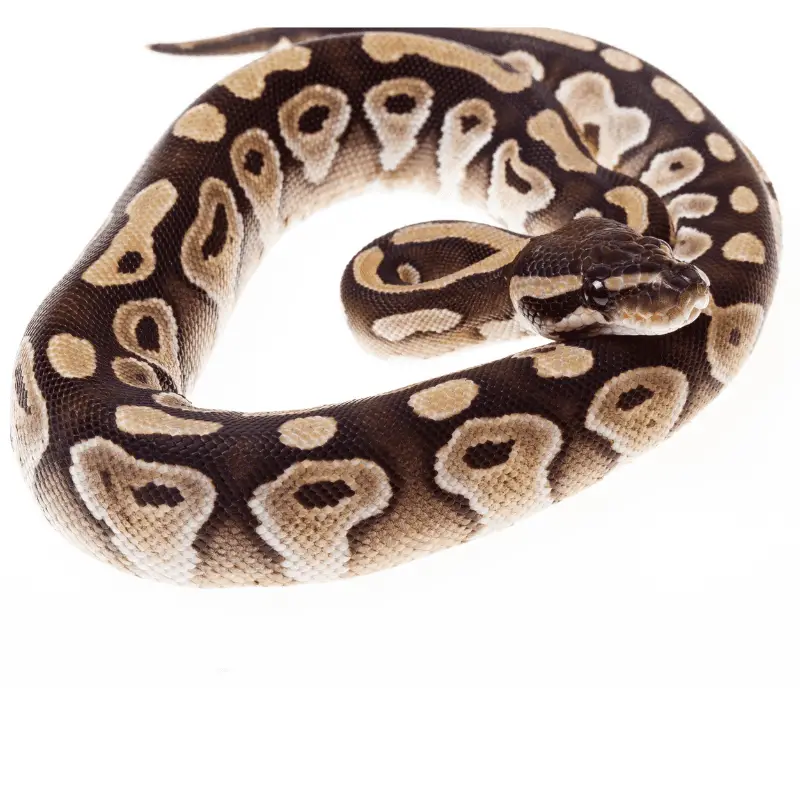
Ball Pythons are the most popular pet snake in the United States. The colour morphs of these snakes have made them so popular among snake fanatics. You can find hundreds of designer morphs of ball pythons in the market. That means there is a suitable choice for everyone.
The even temperament and docile nature of Ball Pythons also make them a favourite among pet owners. Ball Pythons are not giant snakes; however, they are manageable but bigger than some smaller snakes. To accommodate their needs, you need to create hiding places in their enclosure.
Size
The male snakes grow to about 24-36 inches (60-91 cm), and the females grow to 36-60 inches (91-152 cm). However, compared to snakes of similar length, Ball Pythons have stocky bodies.
How long do Ball Python snakes live in captivity?
Ball Python lives for a long time. More often than not, you can find Ball Pythons residing for more than 30 years in captivity.
Before getting a Ball Python for yourself, you should know that these snakes are native to Western and Central Africa. That is why these snakes can accustom themselves to high humidity levels. It would help if you used a hygrometer to monitor the humidity of the enclosure.
3. Ringneck Snake
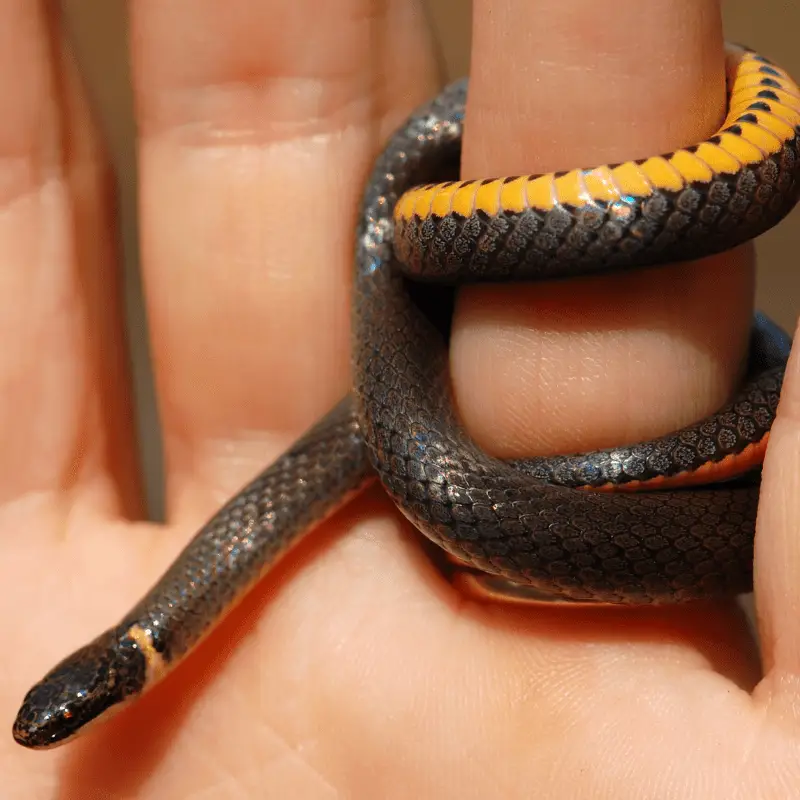
These snakes are tiny in size. Ringneck snakes are so small that you would think they are worms if you do not know better. One of the most distinguishing features of these snakes is the orange necklace-like ring that encircles their neck region. Apart from this orange stripe, the snakes are generally either dark brown or black.
Also, Ringneck snakes are so small in length that most people confuse the adult snake with hatchlings. However, the truth is a fully grown Ringneck snake only grows up to 15 cm in length. They rarely get thicker than a pencil. Wild ringnecks try to eat invertebrates and small worms. It would help to keep this in mind while feeding your Ringneck snake that they only eat tiny food sources.
Size
The Ringneck snakes grow to about 10-15 inches (25-38 cm)
How long do Ringneck snakes live in captivity?
The lifespan of a Ringneck snake in captivity is 20 years.
4. Hognose Snake
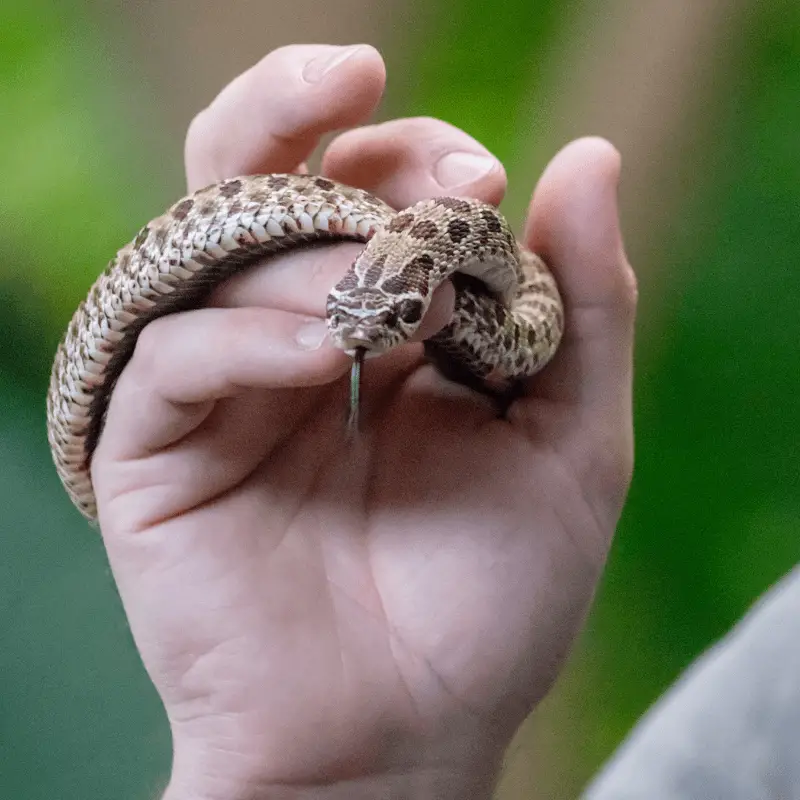
Hognose snakes have very unique-looking snouts that make them adorable as pet snakes. Their short snouts enable them to dig the sand and make a burrow for themselves under the loose soil. These snakes have short bodies with a variety of patterns and colours. The calm nature of these snakes makes them the perfect choice for first-time owners. These snakes share a very similar look to the infamous rattlesnakes. However, they do not have as deadly venom as them. The venom of the Hognose snakes is strong enough to subdue the frogs and other small animals but not dangerous enough to humans.
You should not be worried about getting bit if you choose Hognose snakes as pets as they are very reluctant biters. Even though these snakes are more significant than the other small snake species, you can still consider them while choosing a smaller pet snake. These snakes are readily available in pet stores, and you can get them at an affordable price range.
Size
A hognose snake varies in size depending on the species, western, eastern and southern.
Species: Western Hognose Snake
- Hatchling Size: 5 to 9 inches
- Mature Male Size: 14 to 24 inches
- Mature Female Size: 28 to 36 inches
Species: Eastern Hognose Snake
- Hatchling Size: 6½ to 8 inches
- Mature Male Size: 17 to 24 inches
- Mature Female Size: 28 to 36 inches
Species: Southern Hognose Snake
- Hatchling Size: 6 to 7 inches
- Mature Male Size: 13 to 15 inches
- Mature Female Size: 18 to 22 inches
How long do Hognose snakes live in captivity?
The lifespan of a Hognose snake in captivity is 15-20 years.
5. Corn Snake
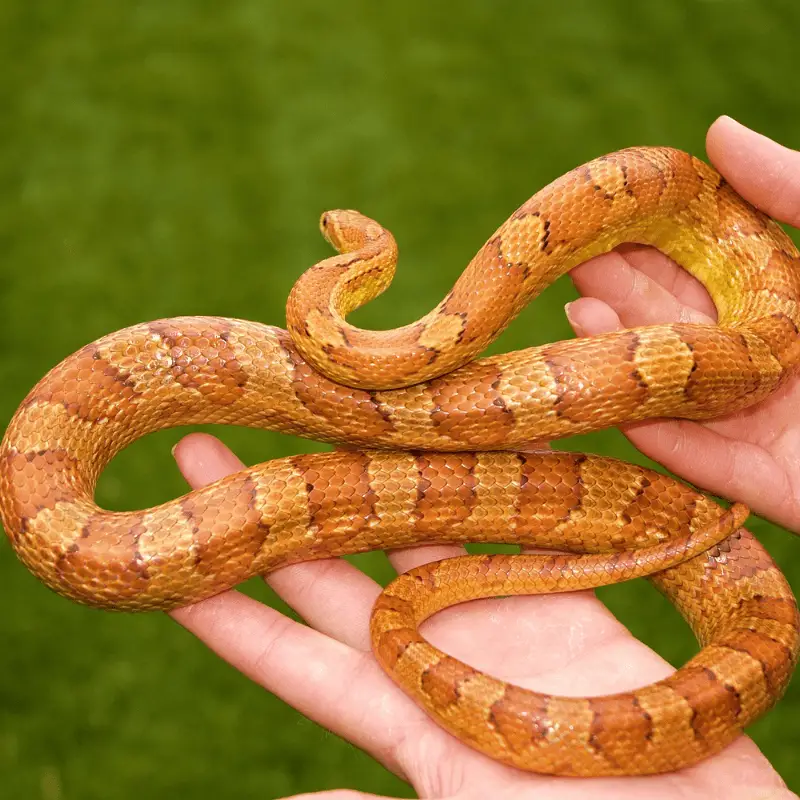
Among beginner snake keepers, corn snake is one of the most popular choices. These snakes are hardy and docile. Corn snakes depend on a rodent-based diet. That means you need to get frozen or thawed rodents for them. In captivity, the snakes rarely refuse their meal. Some snakes also feed on raw chicken straight from the packet. Thanks to the selective breeding processes, these snakes are available in almost every colour. The best things about these snakes are straightforward to handle.
Size
The Corn snakes grow to about 24-71 inches (61-182 cm)
How long do Corn snakes live in captivity?
The lifespan of a Corn snake in captivity is up to 23 years.
6. Scarlet Kingsnake
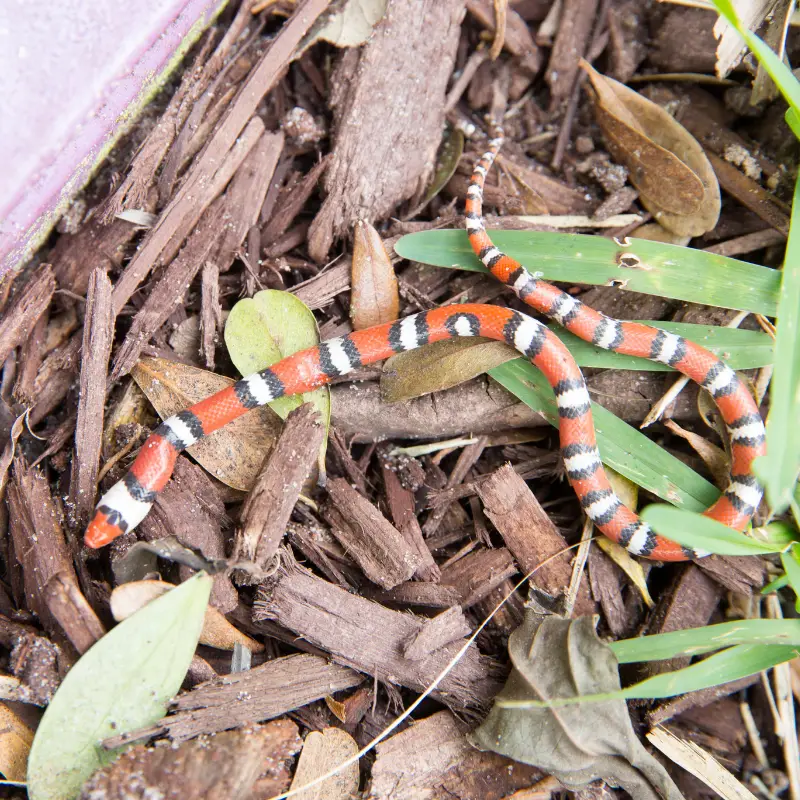
The unique looks of the Scarlet kingsnake snakes make them another favourite among pet owners. You should always have one in a separate enclosure if you consider getting a Scarlet kingsnake as a pet. Never put two Scarlet kingsnakes together, as these snakes are known for their carnivore tendencies on each other. Other than these characteristics, these snakes are pretty manageable. The most common variety is the banded or striped kingsnakes. However, there are different variations available as well.
Size
Scarlet kingsnakes can grow up to 36-48 inches (86-121 cm)
How long do Scarlet kingsnakes live in captivity?
They tend to live between 15 years in captivity.
7. California King Snake
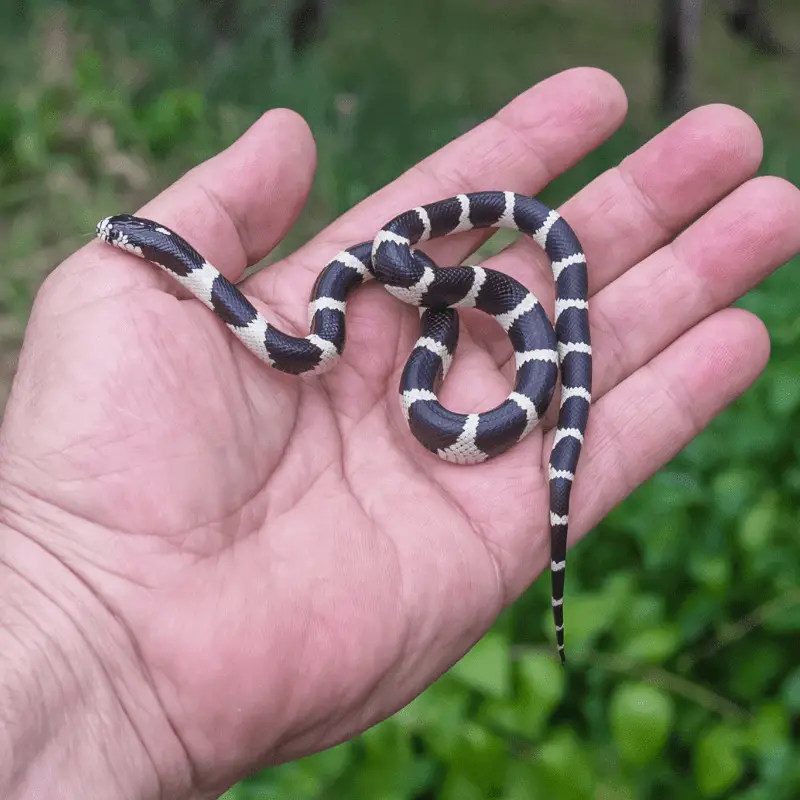
Like the Scarlet Kingsnake, the California Kingsnake is another King snake species widely popular among pet owners. Like The other snakes in this list, the California Kingsnakes have many subspecies. That means the pattern and the colours of these snakes can vary significantly. However, you can find the most common colour to be deep brown. However, in captivity, morphs of these snakes have been bred. That means you can get California kingsnake of your choice of colour. As these snakes are constrictors, they are stronger compared to their size. That’s why these snakes mainly feed on reptiles and other snakes in the wild, which are more challenging to constrict than mammals.
Size
The California kingsnake can grow up to 30-40 inches in size (76-101 cm)
How long do California kingsnakes live in captivity?
They tend to live between 15-20 years in captivity.
8. Barbados Threadsnake
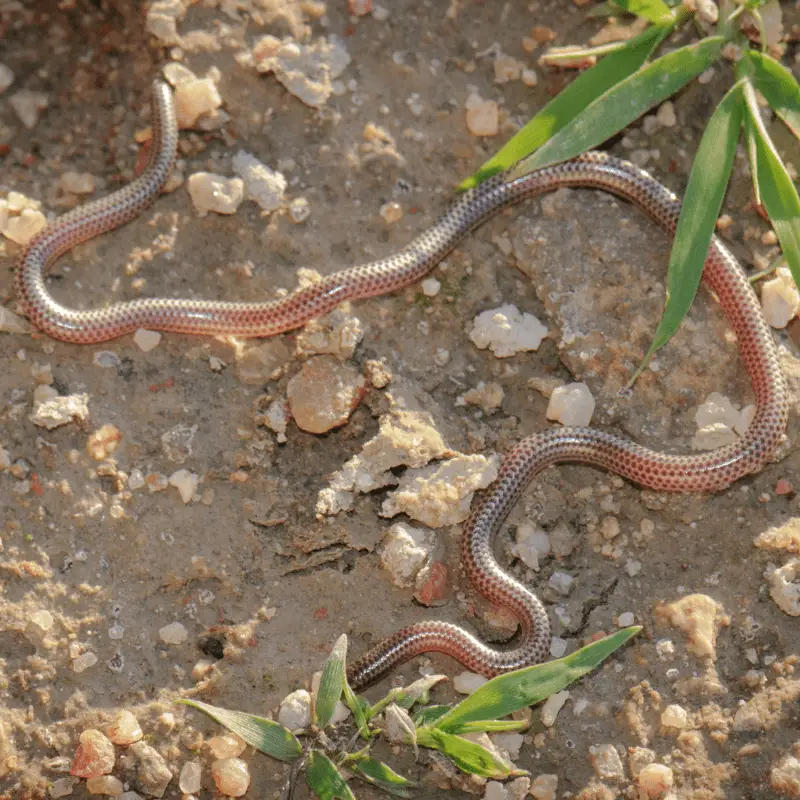
Barbados Threadsnakes are from the islands of Antigua, Barbados in the Caribbean. It is the smallest known snake species in the world. While it is not common for pet owners to keep a Barbados Threadsnake as pets, their small size makes them the perfect pet for beginners.
The hepatologist found these snake species back in 2008. Even though other researchers previously discovered these, they were incorrectly classified as another snake species. The Barbados Threadsnake is so small that you can hardly tell whether it is a snake or not. Compared to the length, these snakes have a thinner body. The Barbados Threadsnake also do not have a prominent head like most snake species. The weight of these snakes is also pretty small. For example, a full-grown Barbados Threadsnake weighs about 0.6 grams.
Size
The Barbados Threadsnake can grow up to 4 inches in size (10 cm)
How long does Barbados Threadsnakes live in captivity?
They tend to live between 25-30 years in captivity.
9. Bimini Blind Snake
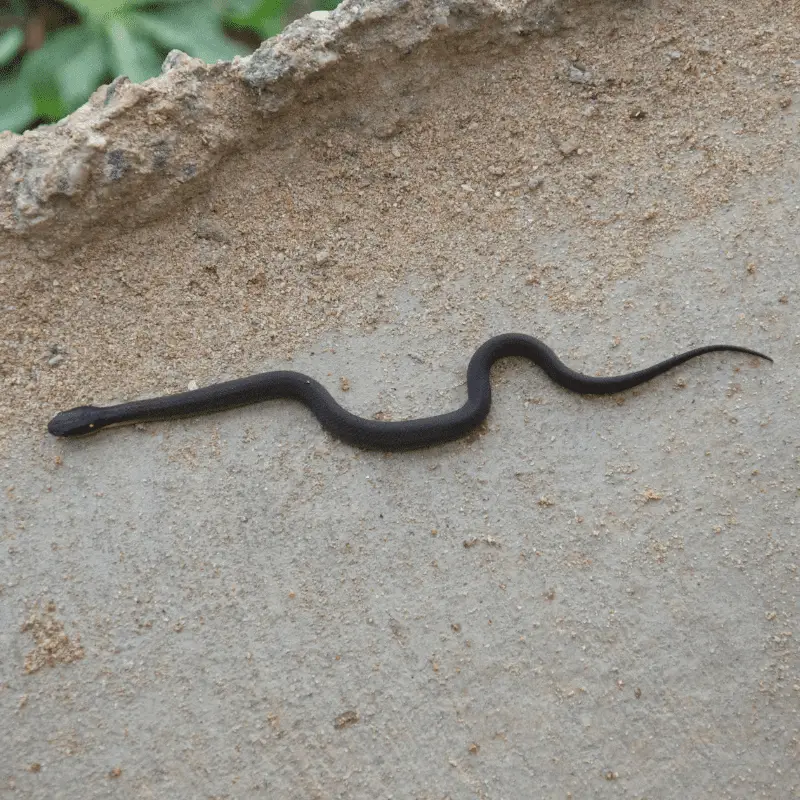
Also known as Brahminy Blind snakes, the Bimini Blind snakes are pretty similar to the Barbados Threadsnakes. These snakes are also known as Island blind snakes, common blind snakes, flowerpot snakes, Hawaiian and blind snakes. Even though these snakes are native to Africa, lately, there has been introduced to America.
According to the researchers, these snakes look very similar to the earthworm. While the Barbados Threadsnakes are smaller than a worm, the Bimini Blind snakes are the same size. It has a shiny thin body without any noticeable presence of scales.
Unlike the Barbados thread snakes, the Bimini Blind snakes are pretty popular as pets. However, they are not as interesting as the slightly larger snakes. Most of the time, these snakes love to stay underground where you cannot see them. The visibility of the Bimini Blind snakes is way more than the Barbados Threadsnake.
Size
The Bimini Blind snakes can grow up to 2-4 inches in size (5.1- 10.2 cm)
How long do Bimini Blind snakes snakes live in captivity?
They tend to live between 25-30 years in captivity.
10. Garter Snake
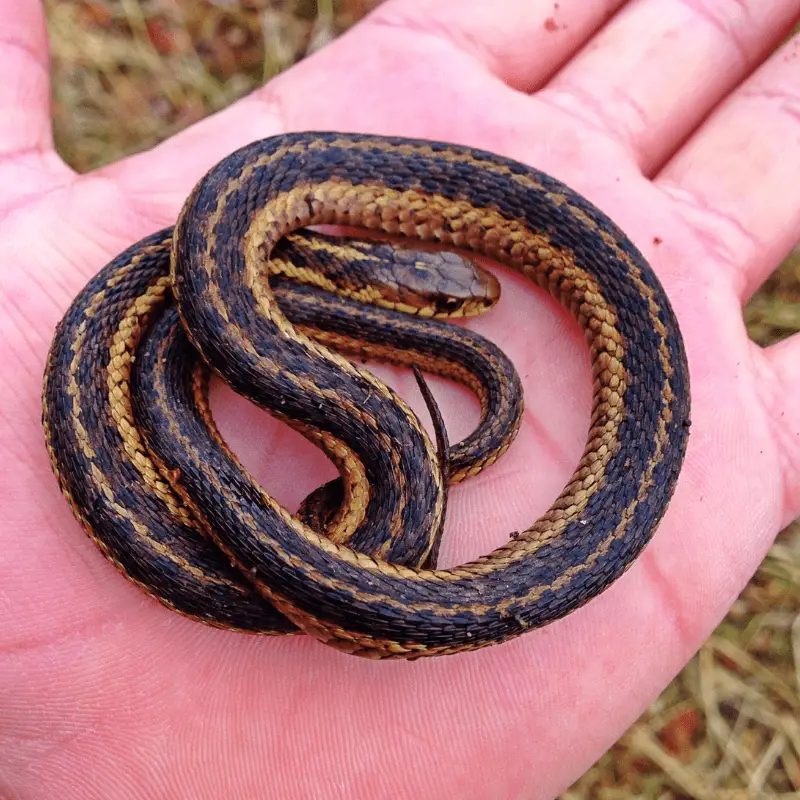
These are yet another small to medium-sized snake species that you can keep as a pet. These snakes are pretty popular pets across the United States. You can even find these snakes in Canada as well. However, Garter snakes are mostly seen in Mexico. As there are several species of Garter snakes available in the wild, patterns and colours vary significantly. It does not matter which species you have; they are all pretty interesting to watch.
In The Wild, if you spot Garter snakes, the chances are you will find them in a mating ball. It is a unique feature of the Garter snakes. During the mating season, several Garter snakes get together to form a ball. You can find hundreds of garter snakes in a single ball.
The length of the garter snake varies as it does not signify a single species. The smallest Garter snakes species can grow up to 18 to 20 inches in length. The giant snakes often grow much bigger than that. The biggest Garter snakes can reach up to 54 inches in length. Just like the length, the weight of these snakes can also vary significantly from one species to the next.
Size
Depending on the species, on average, Garter snakes can grow between 18-54 inches in size (45.7- 137.1 cm)
How long do Garter snakes live in captivity?
They tend to live between 8-12 years in captivity.
11. Rough Green Garden Snake
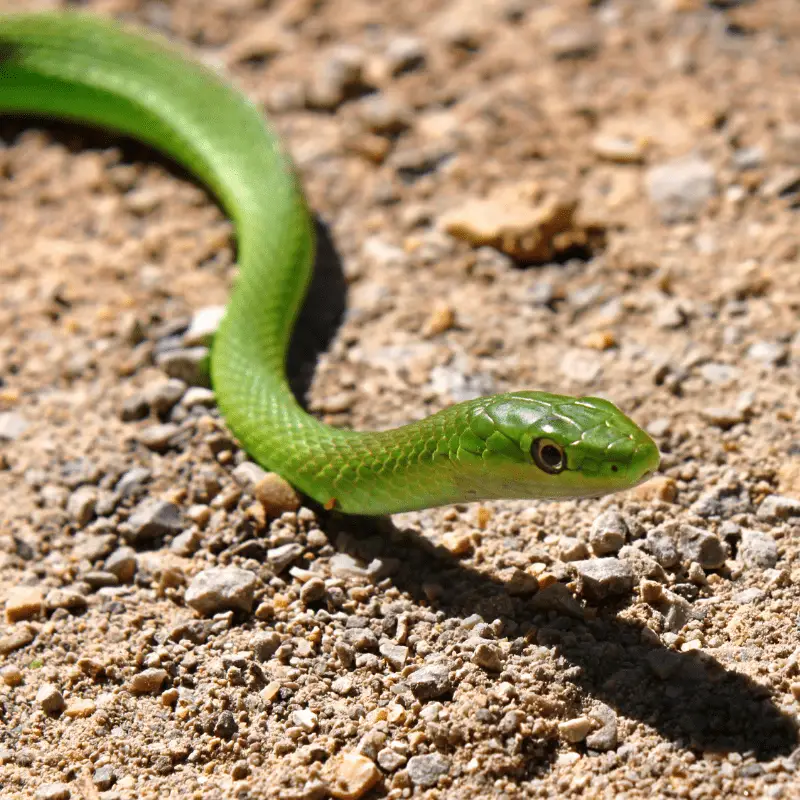
As the name suggests, the rough green snakes are bright green and can be exceptionally slender. The rough green snake can reach up to 46 inches in length. However, thanks to their slim body, these snakes seem much smaller to the naked eye. They only grow up to an inch in diameter. Compared to some other snakes, you can place a rough green garden snake easily in your hand. The male snakes weigh about 16 grams, while the average weight of the female snakes is about 26 grams. Compared to the other snakes, the rough green garden snakes are much lighter.
Size
The Rough Green Garden Snakes can grow up to 46 inches in size (116 cm)
How long do Rough Green Garden Snakes live in captivity?
They tend to live between 10-15 years in captivity.
Heat Lamp Advice
Please be aware that snakes love the heat lamp and often gravitate to it. Unfortunately, my corn snake managed to make its way behind the grills of the heat lamp. When I came down the following morning, he had sadly died. So my advice to you is, make sure the grills are impossible for the snake to get into, since they are so small they can get into all sorts of spaces you wouldn’t think is even possible. Speak to your reptile shop to find the best grills suited for your snake.
Below is a picture of my tank set up showing the heat lamp and the snake size. I was recommended it from the reptile shop as a good choice; however, he managed to get in it. Don’t make the same mistake.
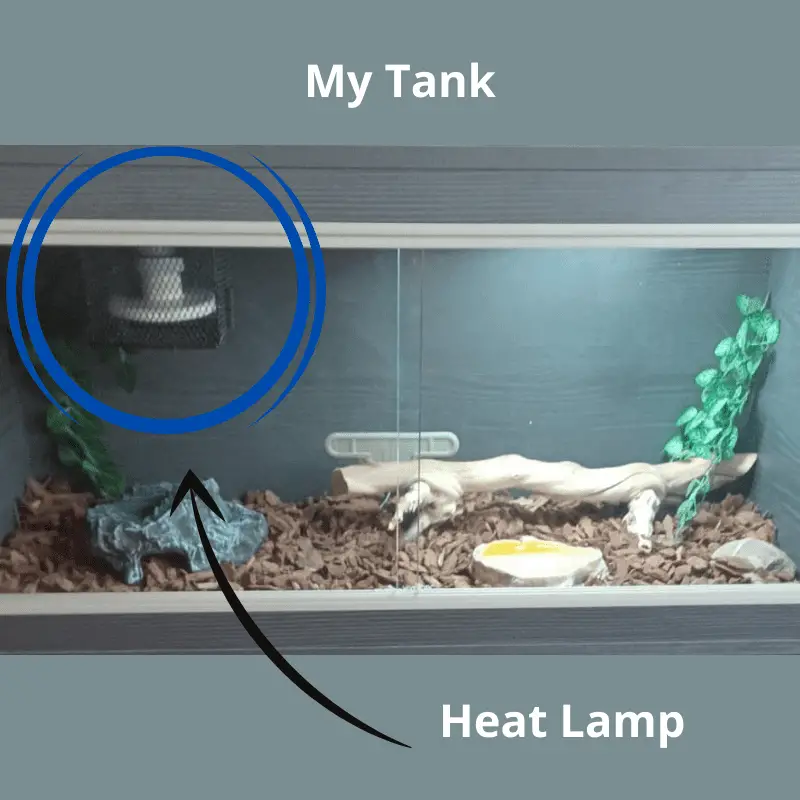
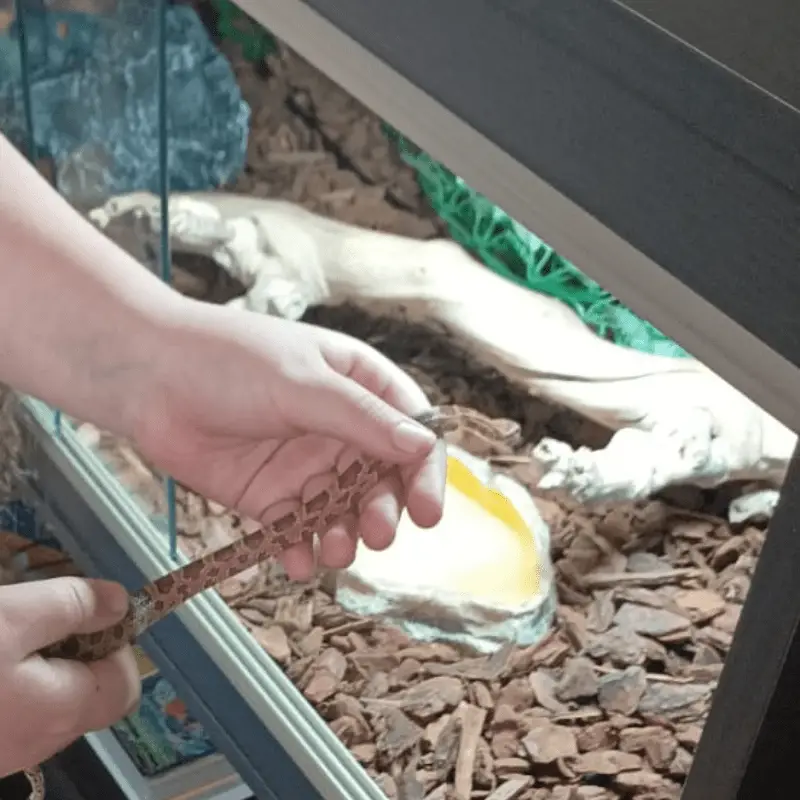
Always keep a spare heat lamp bulb for backup. Snakes need a heat lamp to survive and having a backup one is crucial.
How long do snake heat lamps last?
Heat lamps usually last 3 to 4 months. After this time, the bulb will go out, and you will need to replace it. However, catching the bulb before it burns out will be better for your snake’s health. The temperature will start to drop as soon as it goes out. I recommend changing the bulb every two months to avoid this, even if the bulb hasn’t burned out.
Conclusion
When I was a beginner, the above was all the snakes that I considered. However, I loved the colours of the corn snake, so I chose Number 5. I paid around £65 ($90), and with all the tank bits, it came to about £400 ($550) altogether. I had to wait for the delivery from the pet shop as the day they were bringing him over to me was too hot to transport. There was a mini-heatwave in the UK, but I got him the following week.
Even though all the above snakes are pretty small and easy to handle, they have different housing requirements. Before you get one for yourself, you should gather more information about their food habits, characteristics, and handling details as well. While the snakes are not as warm and interactive as a dog, there is no doubt that they make an interesting pet.
Happy Snake Parenting!

